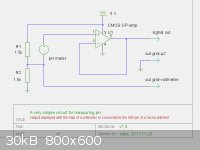seba
Harmless

Posts: 16
Registered: 27-11-2011
Location: SI
Member Is Offline
Mood: No Mood
|
|
A Very Simple Circuit for Measuring pH
The circuit needs a standard 5 V power supply (without a negative rail) and outputs a signal of roughly 2.5 V ± 0.5 V or 0 V ± 0.5 V depending on
the wiring and a suitable pH probe.
Signal out is common for both methods of wiring. The ground differs on type of application. For microcontrollers is better to use the out gnd-µC as
that gives an always positive signal. The other method, suitable more for displaying results with the aid of a voltmeter, is to use out gnd-voltmeter
which will output the signal in a few 100 mV above or bellow 0 V.
pH probes can be bought at various laboratory suppliers, Internet sites or eBay. I've bought a GX-E1 probe on eBay for approx. 12 €, which comes with two different calibration buffers. The rest of the circuit costs around 2 €.
Output of the circuit ideally follows the Nernst equation which gives a value of 0.059 V per pH unit. The lower the pH the higher the voltage and the opposite with basic pHs. Reason of the
opposite sign is in how the buffer amplifier U1 works (inversion of signal).
Because the probe doesn't adhere totally to the ideal equation (usually the change in voltage is slightly less) we must calibrate the instrument with standardized buffers. Usually we use two at different pH values, but you can use more. Most common is the use of two
buffers to get two voltages at known pHs which gives us then the factors k (roughly -0.059, depends on the probe and its age) and c (usually 2.5 or 0,
depends on the wiring and resistors) of the equation pH = k V + c. Sometimes the equation is written as pH = β 0.059 V + c (where β is
usually between 0.98 and 1). If using more buffers we get more points which can be translated to a more correct linear equation with use of the least squares method or to a polynomial equations of higher order.
If you lack a suitable buffer for testing you can prepare it yourself by mixing 2.5 g of citric acid with 0.8 g of NaOH in 100 mL of distilled water. The pH of
such buffer will be roughly 5.01.
The operational amplifier U1 needs to be high-impedance as the pH probe has an internal impedance of approx. 100 MΩ. Suitable technologies are
for example CMOS, JFET, FET. The higher the input impedance of the OP-AMP the less error there will be due to loading. In my test circuit I've used a
Microchip MCP606 OP-AMP.
The resistors don't need to be exactly 1.5 kΩ. Any value around that would do. They are recommended to be the same, but there's no need to. The
resistors form a voltage divider to bring the pH probe's voltage enough above ground, that it never goes negative. That means that as long as the equation 5 R2 /
(R1 + R2) > 0.5 holds it should be fine.
For probe attachment is recommended to use a BNC female connector as that's the industry standard for pH probes. The impedance of the connector is not important as the signal is DC .
A few notes at the end. The probe ages, so with time it will need more time for the probe to settle for a number. The typical probe has to be kept in
a solution of 3-4 M KCl. It cannot be fully submerged in any liquid. The glass bulb at the tip of the probe is sensitive to mechanical stress. All
probes suffer from the so called sodium error which gives erroneously lower pHs at higher pHs if in a solution with high sodium ions.
[1] I've tested with 2.52 g citric acid and 0.80 g NaOH which gave me a pH of 5.01.

|
|
|
zoombafu
Hazard to Others
  
Posts: 255
Registered: 21-11-2011
Location: U.S.
Member Is Offline
Mood: sciencey
|
|
Great idea and a great post! I love electronics, so I'll have to give this a try.
|
|
|
seba
Harmless

Posts: 16
Registered: 27-11-2011
Location: SI
Member Is Offline
Mood: No Mood
|
|
The old probe's link doesn't work anymore. New link here: http://www.gainexpress.com/products/single-cylinder-ph-elect...
|
|
|
IrC
International Hazard
    
Posts: 2710
Registered: 7-3-2005
Location: Eureka
Member Is Offline
Mood: Discovering
|
|
http://www.ebay.com/itm/BNC-Connector-Electrode-PH-Probe-Sen...
http://www.ebay.com/itm/201DH-PH-PH-electrode-ph-sensor-ph-p...
These two will likely be available for a long time.
http://www.ebay.com/itm/PH-ELECTRODE-BNC-70cm-LONG-CABLE-2-x...
If this auction ends check for a new listing.
"Science is the belief in the ignorance of the experts" Richard Feynman
|
|
|
aga
Forum Drunkard
    
Posts: 7030
Registered: 25-3-2014
Member Is Offline
|
|
Neat idea.
Lift the pH probe from 0v with a potential divider.
Seems more elegant than the thing i tried a few days ago :
http://electronics.stackexchange.com/questions/32318/how-can...
For those who don't know, a pH probe will give a positive or a negative voltage, depending on pH above or below 7.
|
|
|